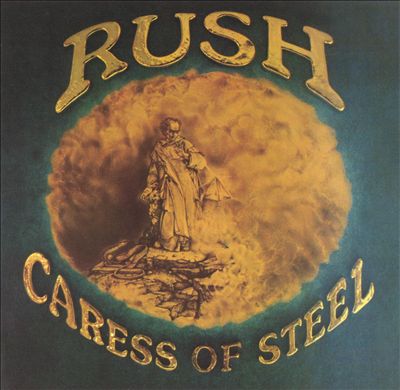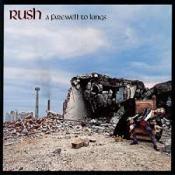20 Rush Albums in 20 Days: Caress of Steel
 DAY TWENTY: Caress of Steel, running time 44:59, released September 24, 1975
DAY TWENTY: Caress of Steel, running time 44:59, released September 24, 1975
Caress of Steel, an album I’ve long considered to be Rush’s worst, is not as bad as I remember. In fact, it has a lot of things going for it, though I admit I won’t likely be listening to it again anytime soon. This is an ambitious effort, a full 7 minutes longer than Fly by Night, with the band’s first side-long song, “The Fountain of Lamneth.”
The opening song “Bastille Days” is basically “Athem 2,” a rip-roaring number that was a live favorite for a number of tours. The band shows its first signs of a sense of humor on the throw-away track, “I Think I’m Going Bald,” a song that would have been better suited on Rush despite it being penned by Peart, and the very accessible “Lakeside Park” is a pleasant tune, oddly out of place considering what’s to transpire (and the guitar is annoyingly panned all the way left during the verses for some inexplicable reason).
“The Necromancer” is Rush’s second venture into the land of extended, multi-section pieces, and it’s an effective one save for the warped, slow-tape narration. The first movement – the song’s best – is a moody, repetitious, minor-keyed movement reminiscent of a Pink Floyd jam, and the second section brings to mind “Cygnus X-1” with its sudden starts and stops. The growl of By-Tor come back briefly, but unlike on the Fly By Night album, Geddy wisely get’s out of the way of Lifeson’s solos (regrettably panned back and forth, an amateurish and unnecessary production trick), and the last section has a fine, three-chord outro (think “Sweet Jane”) that gives the song a melodic, positive lift.
Hearing “The Fountain of Lamneth” for the first time in years, I found it alternately brilliant and regrettable. The first section, “In the Valley,” opens with a beautiful descending acoustic guitar pattern and melodic lyric that would play very well live as part of a largely medley, but then Geddy screeches his way through the next part. The minute-long “Didacts and Narpets” is unfortunate in every way except that it’s only a minute long. “No One At The Bridge” recalls the first section of “The Necromancer,” with a moody, hypnotic verse and terrific guitar solo; the only issue is the bridge when Geddy sounds like he’s about to tear his vocal chords apart (and not in a good way). He takes it down several registers in the next two sections, and they are better for it. “Panacea” is a flowing ballad, and “Bacchus Plateau” is the album’s most accessible tune, a three-chord pop song at its essence; if this were separate from the rest of the side-song piece it might have been a modest radio hit, and if Geddy could still hit the notes, it would be a great live piece. “The Fountain” ends the album side where it began, offering the listener some familiar territory, a helpful bookend.
So where does it stand head-to-head against other Rush albums? It's hard to say. Comparing Caress of Steel to, say, Snakes and Arrows, is like comparing two different bands. In a way, they are two different bands.
Twenty albums in twenty days! Tomorrow, I’ll be summarizing my journey, and then I’m taking a week to listen to some other music.



